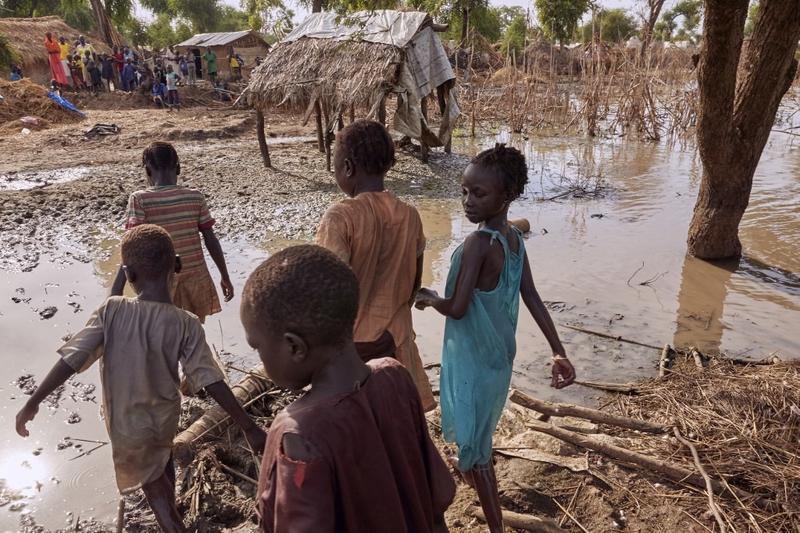 Children walk through the remaining flood waters in Yusuf Batir refugee camp in Maban, South Sudan on Nov 25, 2019.
(ALEC MCBRIDE / AFP)
Children walk through the remaining flood waters in Yusuf Batir refugee camp in Maban, South Sudan on Nov 25, 2019.
(ALEC MCBRIDE / AFP)
The health and future of every child and adolescent in the world today is under immediate threat from ecological degradation, climate change and exploitative marketing practices that push fast food, sugary drinks, alcohol and tobacco at children.
The findings are contained in a report entitled "A Future for the World’s Children?" by a commission of experts set up jointly by the World Health Organisation (WHO), the United Nations Children's Fund (UNICEF) and The Lancet, a leading medical journal. The report was financed by the Bill and Melinda Gates Foundation.
READ MORE: Amnesty: Climate change tops list of global issues for young people
The report includes a new global index of 180 countries comparing performance on child survival and well-being, based on health, education, nutrition and sustainability, as well as greenhouse gas emissions, and equity or income gaps.
China is ranked 43 out of 180 for its performance on child survival, just behind the United States on 39. Norway was ranked number one, according to the report "A Future for the World’s Children?"
China is ranked 43 out of 180 for its performance on child survival, just behind the United States on 39. Norway was ranked number one.
The report, released globally on Wednesday, found no single country is adequately protecting children’s health, their environment and their futures.
“Despite improvements in child and adolescent health over the past 20 years, progress has stalled, and is set to reverse,” said former prime minister of New Zealand and co-chair of the commission, Helen Clark.
“It has been estimated that around 250 million children under five years old in low- and middle-income countries are at risk of not reaching their developmental potential, based on proxy measures of stunting and poverty. But of even greater concern, every child worldwide now faces existential threats from climate change and commercial pressures.
“Countries need to overhaul their approach to child and adolescent health, to ensure that we not only look after our children today but protect the world they will inherit in the future,” she said in a statement released on Wednesday.
According to the report, while the poorest countries need to do more to support their children’s ability to live healthy lives, excessive carbon emissions – disproportionately from wealthier countries – threaten the future of all children.
ALSO READ: WHO: Childhood, adolescent obesity up tenfold in past four decades
If global warming exceeds 4°C by the year 2100 in line with current projections, this would lead to devastating health consequences for children, due to rising ocean levels, heatwaves, proliferation of diseases like malaria and dengue, and malnutrition.
Despite improvements in child and adolescent health over the past 20 years, progress has stalled, and is set to reverse
Helen Clark, commission's co-chair
The report also highlights the distinct threat posed to children from harmful marketing. Evidence suggests that children in some countries see as many as 30,000 advertisements on television alone in a single year, while youth exposure to vaping (e-cigarettes) advertisements increased by more than 250 percent in the United States over two years, reaching more than 24 million young people.
Professor Anthony Costello, one of the report’s authors, said: “Industry self-regulation has failed”.
He said studies in Australia, Canada, Mexico, New Zealand and the US – among many others – have shown that self-regulation has not hampered commercial ability to advertise to children.
“For example, despite industry signing up to self-regulation in Australia, children and adolescent viewers were still exposed to 51 million alcohol ads during just one year of televised football, cricket and rugby. And the reality could be much worse still: we have few facts and figures about the huge expansion of social media advertising and algorithms aimed at our children,” he said in a statement also released on Wednesday.
Evidence suggests that children in some countries see as many as 30,000 advertisements on television alone in a single year, while youth exposure to vaping (e-cigarettes) advertisements increased by more than 250 percent in the US over 2 years
Children’s exposure to commercial marketing of junk food and sugary beverages is associated with purchase of unhealthy foods and overweight and obesity, linking predatory marketing to the alarming rise in childhood obesity. The number of obese children and adolescents increased from 11 million in 1975 to 124 million in 2016 – an 11-fold increase, with dire individual and societal costs.
The commission’s authors called for a new global movement cantered on children with new policies and investments to improve child health and rights, and to incorporate their voices into policy decisions.
They recommended that nations terminate carbon dioxide emissions immediately to safeguard the future of the young.
ALSO READ: Call for ban on e-cigarettes in public spaces to protect minors
Richard Horton, editor-in-chief of The Lancet said: “From heads-of-state to local government, from UN leaders to children themselves, this Commission calls for the birth of a new era for child and adolescent health. It will take courage and commitment to deliver. It is the supreme test of our generation.”
Associate professor Grant Blashki from the Nossal Institute for Global Health at the University of Melbourne said the findings of the report will “reverberate through public policy around the world”.
“In many ways this timely report quantifies many of the common sense global health principles that recognize the powerful social determinants of children’s health and specifically the need for a safe climate and a healthy food environment for children to thrive,” he said.


